Pre-emphasis works by boosting the high-frequency portion of the signal. This compensates for the high-frequency loss in the cable. De-emphasis works by cutting the low-frequency portion of the signal. This may be coupled with an increased transmit voltage.As we know noise usually will have higher amplitude and higher frequency components. This high frequency noise will lead to frequency distortion when its amplitude is higher than the components present in the modulating signal. To overcome this situation most of the FM circuits use techniques known as Pre-emphasis at the transmitter and De-emphasis at the receiver.
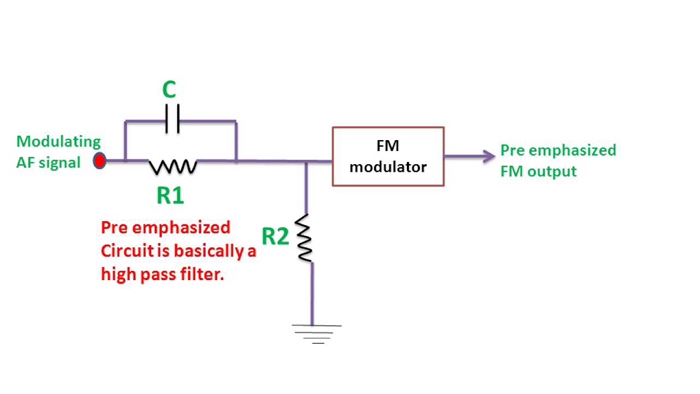
CONTENT
1.What is pre-emphasis and why is it used?
2.What is de-emphasis and when is it use?
3.How to change 50us and 75us in pre-emphasis and de-emphasis?
4.How pre-emphasis is done?
5.What is the purpose of using Preemphasis and deemphasis in FM transmitters and receivers?
6.What is the need of pre-emphasis and de-emphasis?
7.Pre-emphasis and De-emphasis circuit
7.How to change 50us and 75us in pre-emphasis and de-emphasis?
What is pre-emphasis and why is it used?
Theory has proved, frequency of the output noise power spectrum by the square of the frequency law of increase. However, many actual message signals, such as language, music, and their power spectrum decreases with increasing frequency, most of its energy concentrated in low frequency range. This has resulted in high-frequency end of the message signal to noise ratio may be reduced to the extent not allowed. However, due to the higher frequency components of the message signal energy is small, rarely enough to produce the largest range of frequency offset, resulting in the maximum deviation of the signal amplitude mostly caused by the low frequency signal. On average, a minor deviation produced much less high frequency components. So FM signal and not fully occupy the bandwidth given to it.Because the FM bandwidth of the system need to send the message by the signal (modulation signal) of the most significant decisions of the frequency and maximum frequency deviation. However, the rec eiver input noise spectrum occupy the entire frequency bandwidth. This means that, in the frequency discriminator output noise power spectrum at higher frequencies have been increased.
To offset this undesirable phenomenon, in the FM system is widely used a technique called pre-emphasis and de-emphasis measures, the central idea is to use the signal and noise characteristics of the signal differences to effectively deal with.Before the introduction of noise with the appropriate network (pre-emphasis network), artificially increase (enhance) the transmitter input modulation signal frequency components. Then at the receiver output of frequency discriminator, and then vice versa, ie to increase the use of high frequency components to increase the network to restore the original signal power distribution. In the de-emphasis process, but also reduces high frequency noise, but the pre-emphasis on noise and not affect the output thus effectively improving the signal to noise ratio.
When the signal loss in the transmission channel between Transmitter and Receiver is large, and the signal observed at the Receiver end is lower than the receiving sensitivity required by the Receiver, pre-emphasis should be used.
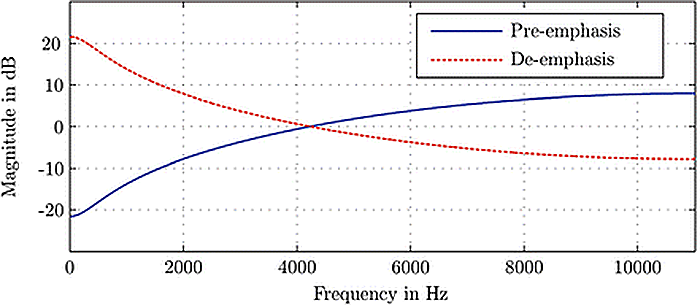
What is de-emphasis and when is it use?
Signal de-emphasis is a signal-enhancing technology that is usually used to improve the quality of electrical signals transmitted at gigabit rates on equipment including PCBs and long cables. Signal attenuation can be caused by a variety of reasons, including long transmission lines and jitter, so this technology helps solve these problems by reducing low-frequency data to minimize signal loss. Understand how de-emphasis works and how to use it to improve signal integrity issues.
De-emphasis is usually used in high-speed systems and is usually classified as 1Gbps or higher. Signal de-emphasis is common in HDMI and DisplayPort cables. As we all know, HDMI cables most actively use signal de-emphasis, because they are often made longer. Since SuperSpeed USD is a faster interface than its corresponding USB 2.0 interface, it must consider transmission effects and use equalization to ensure the signal There is less reduction in integrity.
How pre-emphasis is done?
Pre-emphasis is a method that only enhances the high-frequency components of the signal while leaving the low-frequency components in their original state. It runs by boosting high-frequency energy every time data conversion occurs.
What is the purpose of using Preemphasis and deemphasis in FM transmitters and receivers?
Pre-emphasis increases the amplitude of higher signal frequencies, thereby increasing the signal-to-noise ratio. At the output of the discriminator in the FM receiver, the de-emphasis network restores the original signal power distribution. And de-emphasis means to attenuate these frequencies by the amount they are boosted. The pre-emphasis is done in the transmitter, and the de-emphasis is done in the receiver. The purpose of this is to improve the signal-to-noise ratio of FM reception.
What is the need of pre-emphasis and de-emphasis?
The working principle of pre-emphasis is to enhance the high-frequency part of the signal, which just compensates for the high-frequency loss in the cable. The working principle of de-emphasis is to cut off the low-frequency part of the signal, and this may be combined with the increased transmit voltage.
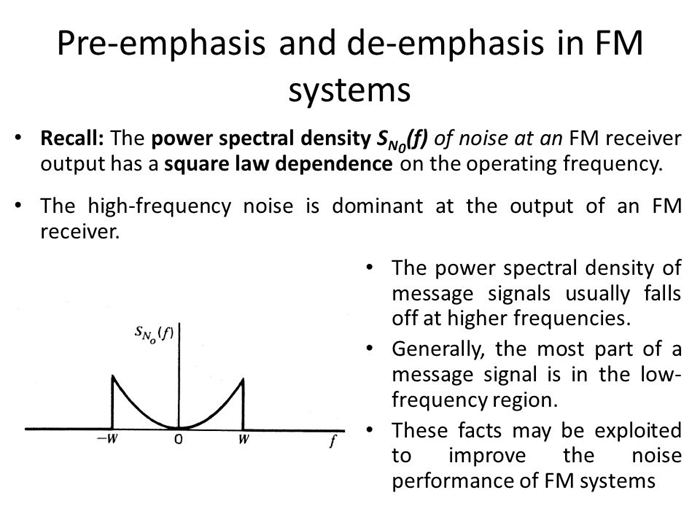
Pre-emphasis and De-emphasis circuit
pre-emphasis circuit
At the transmitter, the modulated signal passes through a simple network that amplifies high-frequency components instead of low-frequency components. The simplest form of this circuit is a simple high-pass filter of the type shown in Figure (1). The specification stipulates that the time constant is 70 microseconds, where t = RC. Any combination of resistor and capacitor (or resistor and inductor) that gives this time constant will be the best. The cut-off frequency fco of this circuit is 2122Hz. This means that frequencies higher than 2122 Hz will increase linearly. The output amplitude increases with frequency at a rate of 6dB per octave. The pre-emphasis curve is shown in Figure (2). Such pre-emphasis circuits increase the energy content of high-frequency signals, so they tend to become stronger than high-frequency noise components. This improves the signal-to-noise ratio and improves clarity and fidelity.
The pre-emphasis circuit also has an upper limit interrupt frequency fu, at which the signal enhancement becomes flat. See Figure (2). The expression for this upper interrupt frequency is: fu=R1+(R12/2πR1R1C), which is usually set to a very high value beyond the audio range. Fu greater than 30KHz is relatively common.
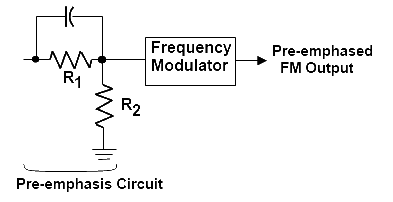
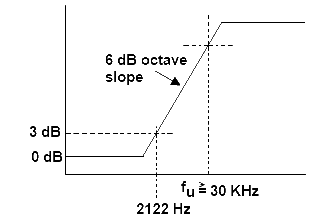
Figure (1). Figure(2)
De-emphasis circuit
In order to restore the frequency response to a normal level, a de-emphasis circuit is used on the receiver. This is a simple low-pass filter with a constant of 75π. See figure (3). It has a cut-off frequency of 2122Hz and attenuates signals above this frequency at a rate of 6dB per octave. The response curve is shown in Figure (4). As a result, the pre-emphasis of the transmitter is accurately offset by the de-emphasis circuit in the receiver, providing a policy frequency response. The combined effect of pre-emphasis and de-emphasis is to increase the high-frequency components in the transmission process, making them stronger without being masked by noise.
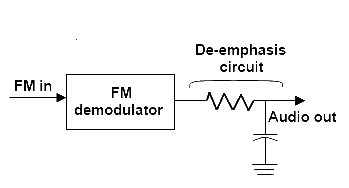
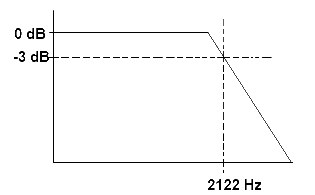
Figure(3) Figure(4)
Welcome to share this post if it is helpful to you!
If you want to know more about Pre-emphasis or De-emphasis, then you can contact us.
Contact: Sky Blue
Cellphone: +8615915959450
WhatsApp: +8615915959450
WeChat: +8615915959450
QQ: 727926717
Skype: sky198710021
E-mail: [email protected]
You may search for these questions:
1.FMUSER NEW 1W FU-X01AK FM Transmitter FM radio broadcaster 50usd/70us Pre-emphasis 0-1w Power Output Adjustable with Antenna Power Supply Kit
2.How To Do Live Church On Youtube And Facebook ?
3.How to Convert Encoder Protocol ?
How to change 50us and 75us in pre-emphasis and de-emphasis?
50/75us pre/de-emphasis FM channel compensation technology, 75us is the American standard, and 50us is the European standard.
Most of the transmitters made in China are 50us, so if we want to change the Chinese 50us to 75us, it is necessary to visit the area near the BH1414K IC, where the RC components (resistors and capacitors) are located in this area to perform magic.
After access, the components that need to be changed will be connected to pins 5 (left channel audio input) and 7 (right channel audio input) of BH1414K IC. The operational amplifier and R1 are located inside the IC. R1,2 and C3,4 are outside the IC on the circuit board. Depending on the circuit board manufacturer, the two capacitors that actually need to be replaced may be marked as something other than C3 and C4 on the circuit board, but a closer look will reveal which two capacitors they are. Refer to the attached schematic pictures to determine how they are connected in the circuit. Two 1000 pf (picofarad) capacitors need to be removed and replaced with 1500 pf (picofarad) capacitors at the corresponding positions on the circuit board. These capacitors are of surface mount type. For a pre-emphasis value of 50us, use a capacitor of 1000 pf value, and for a pre-emphasis of 75us, use a capacitor value of 1500 pf. I have included some images to help with component location and circuit description.
The pre-emphasis tweeter boost capacitor is 1000pF for 50us and 1500pF for 75us. The audio input coupling capacitor determines which low frequencies pass, and for BH1414K it is 1uF polarization. In fact, any value of R1, R2 and C3, C4 can be used, as long as their value is equal to the correct value required for 75us pre-emphasis.
EG, the values used on the circuit board are R1, R2=51K Ohms, C3, C4=1500pf for 75us pre-emphasis or 1000pf for 50us pre-emphasis. The calculation formula is: RXC = T (51,000 X .0015 = 76.5 (close to 75us).
Multiply by 51000 X .001 = 51 (close to 50us)
Our other product:






















